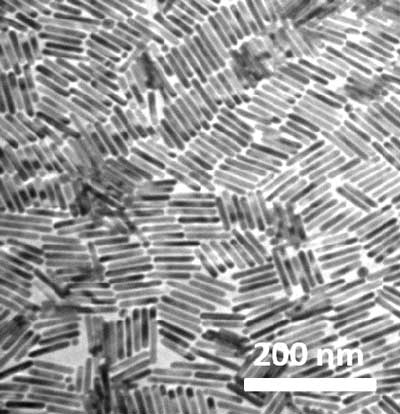Nanorods: Elongated Nanostructures with Unique Properties and Applications
What are Nanorods?
Nanorods are elongated nanostructures with a diameter in the nanometer range and an aspect ratio (length-to-width ratio) greater than one. They are typically characterized by their unique optical, electrical, and magnetic properties that arise from their anisotropic shape and quantum confinement effects. Nanorods have garnered significant attention in various fields, including optoelectronics, energy storage, catalysis, and biomedicine.

Types of Nanorods
Nanorods can be synthesized from various materials, each offering unique properties and applications:
- Gold Nanorods: Gold nanorods exhibit strong surface plasmon resonance and have been extensively studied for applications in photothermal therapy, biosensing, and photonics.
- Silver Nanorods: Silver nanorods possess excellent electrical conductivity and have been explored for applications in transparent electrodes, surface-enhanced Raman scattering (SERS), and antimicrobial agents.
- Semiconductor Nanorods: Semiconductor nanorods, such as those made from cadmium selenide (CdSe) and zinc oxide (ZnO), exhibit unique optical and electronic properties, making them suitable for applications in solar cells, light-emitting diodes, and quantum computing.
- Magnetic Nanorods: Magnetic nanorods, such as those made from iron oxide (Fe3O4) and nickel (Ni), exhibit strong magnetic anisotropy and find applications in data storage, magnetic sensing, and biomedical imaging.
Synthesis of Nanorods
Several methods have been developed for the synthesis of nanorods, each offering control over the size, shape, and composition of the resulting nanostructures:
- Template-Based Synthesis: This approach involves the use of porous templates, such as anodic aluminum oxide (AAO) or mesoporous silica, to guide the growth of nanorods. The template acts as a mold, restricting the growth of the material in two dimensions while allowing elongation in the third dimension.
- Solution-Based Synthesis: Solution-based methods, such as the seed-mediated growth and hot-injection techniques, rely on the controlled nucleation and growth of nanocrystals in a liquid medium. By adjusting the reaction conditions, such as temperature, precursor concentration, and surfactants, the aspect ratio of the nanorods can be tuned.
- Vapor-Phase Synthesis: Vapor-phase methods, including chemical vapor deposition (CVD) and physical vapor deposition (PVD), involve the deposition of materials from a vapor phase onto a substrate. By controlling the substrate temperature, gas flow rates, and precursor concentrations, nanorods with desired properties can be obtained.
Properties of Nanorods
Nanorods exhibit distinctive properties that differ from their bulk counterparts:
- Optical Properties: Nanorods possess unique optical properties due to their anisotropic shape and quantum confinement effects. They exhibit strong absorption and emission in the visible and near-infrared regions, making them attractive for applications in photonics, imaging, and sensing.
- Electronic Properties: The elongated structure of nanorods leads to directional charge transport and high carrier mobility along their length. This makes them promising candidates for electronic devices, such as field-effect transistors, solar cells, and light-emitting diodes.
- Magnetic Properties: Magnetic nanorods exhibit shape anisotropy, resulting in enhanced magnetic properties compared to spherical nanoparticles. They find applications in data storage, magnetic sensing, and biomedical imaging.
- Catalytic Properties: Nanorods possess high surface-to-volume ratios and exposed crystal facets, making them efficient catalysts for various chemical reactions. They have been explored for applications in energy conversion, environmental remediation, and chemical synthesis.
Applications of Nanorods
The unique properties of nanorods have led to their exploration in diverse fields:
Optoelectronics
Nanorods have been employed in the development of advanced optoelectronic devices, such as solar cells, photodetectors, and light-emitting diodes. Their elongated structure enables efficient light absorption and charge transport, leading to enhanced device performance and efficiency.
Energy Storage
Nanorod-based materials have shown promise in energy storage applications, particularly in lithium-ion batteries and supercapacitors. The high surface area and short diffusion paths of nanorods facilitate fast charge/discharge rates and improved energy density.
Sensing and Imaging
The optical properties of nanorods make them attractive for sensing and imaging applications. They have been utilized in the development of biosensors, chemical sensors, and fluorescent probes. Nanorods have also been explored as contrast agents for biomedical imaging techniques, such as magnetic resonance imaging (MRI) and computed tomography (CT).
Drug Delivery and Therapeutics
Nanorods have been investigated as carriers for targeted drug delivery and therapeutic applications. Their elongated structure allows for high drug loading capacity and controlled release kinetics. Additionally, the surface of nanorods can be functionalized with targeting ligands for specific cell or tissue targeting.
Safety and Environmental Considerations
While nanorods offer numerous advantages, it is crucial to consider the potential safety and environmental implications associated with their use. The small size and high surface reactivity of nanorods may lead to unique toxicological effects compared to their bulk counterparts. Thorough investigation of the biocompatibility, biodegradability, and long-term fate of nanorods in biological systems is necessary to ensure their safe use in biomedical applications.
Furthermore, the release of nanorods into the environment during their production, use, and disposal should be carefully evaluated. The potential ecological impact of nanorods on aquatic and terrestrial ecosystems, as well as their interactions with other environmental contaminants, requires comprehensive assessment. Proper guidelines and regulations for the safe handling, storage, and disposal of nanorod-containing materials should be established to minimize any adverse environmental consequences.
Challenges and Future Perspectives
Despite the remarkable progress in nanorod research, several challenges need to be addressed for their widespread application. One of the main challenges is the precise control over the size, shape, and composition of nanorods during synthesis. Achieving monodispersity and reproducibility in nanorod synthesis remains a critical goal.
Future research in nanorod development will focus on the exploration of novel materials and the optimization of synthesis methods for large-scale production. The integration of nanorods with other nanostructures, such as quantum dots and nanosheets, will enable the creation of multifunctional hybrid systems with enhanced properties. Additionally, the investigation of nanorods for in vivo applications, such as targeted drug delivery and bioimaging, will be a key area of research.
Further Reading
Oriental Journal of Chemistry, A Review on Nanorods - An Overview from Synthesis to Emerging, Device Applications and Toxicity
Journal of Materials Science: Materials in Medicine, A review on the origin of nanofibers/nanorods structures and applications
